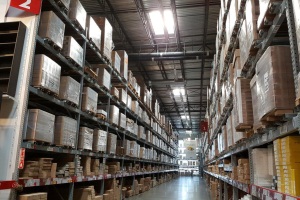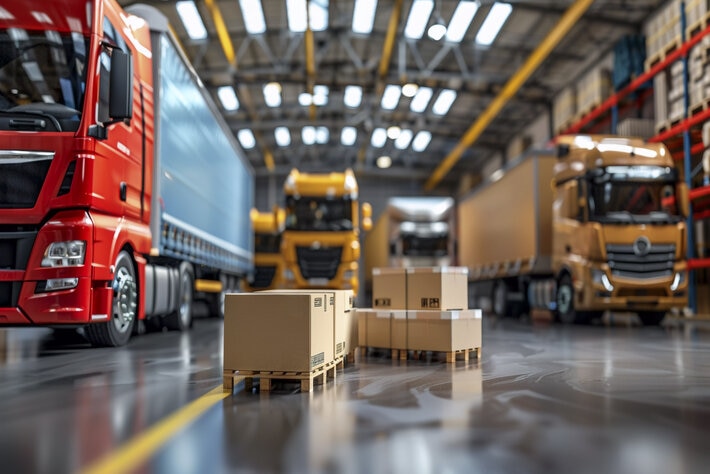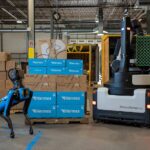The growth of the e-commerce sector has created considerable pressure for advances in logistics and supply chain processes. Customers have come to expect ever greater speed of delivery creating a considerable incentive to accelerate fulfilment times and accurately predict delivery times. This has put a strain on existing infrastructure such as warehouses, encouraging greater efficiency in intralogistics operations which were already one of the most vital components of any company’s supply chain.

Intralogistics operations encompass the internal management of flows of materials, products and information within a facility. It includes all logistical operations from the receipt of raw materials to the completion of the final product and delivery into distribution networks, and encompasses multiple dimensions such as inventory management, internal transportation optimisation, workflow optimisation, order management and in-factory asset tracking and monitoring.
With rapid advances in digital technologies such as robotics, (specifically including autonomous guided vehicles and autonomous mobile robots), artificial intelligence (AI) and the Internet of Things (IoT), companies can now optimise their intralogistics processes more easily and achieve better results. The following sections focus on a range of key aspects that can be significantly improved by leveraging digital technologies in support of intralogistics.


Warehouse management
Companies are aiming to increase the level of automation in warehouses to accommodate growing ecommerce demand and often also to mitigate challenges related to labour shortages. With automated guided vehicles (AGVs) and autonomous mobile robots (AMRs) companies can automate transportation, handling and replenishment of products and materials, and other repetitive and potentially strenuous warehouse activities.
For example, AGVs may be used to transport inventory from long term storage locations to forward-picking locations to replenish stock and ensure that adequate inventory is accessible to pickers, making the order-picking process more efficient. Order picking is one of the most strenuous tasks in a warehouse and automating this process can relieve stress on workers and unlock significant improvements in worker productivity by minimising worker walking time and time spent carrying or pushing carts. For example, by deploying AMRs in its warehouse to handle workflows like order picking, U.S. company Ryder System achieved a 25% increase in productivity and a 20% decrease in operational costs by reducing travel time in the warehouse. With automation, companies can achieve faster order fulfilment, improved order accuracy and reduced picking error rates, which eventually help in increasing customer satisfaction levels and reduces costs resulting from the need to remedy any errors. Further benefits can be realised due to the reduced spacing that is needed between storage racks in warehouses that utilise AGVs; in some cases saving around 30% of floorspace.
Wearables (such as headsets, smart glasses, smart gloves, ring scanners and tablets) are often used in warehouses to optimise worker movements, enable picking and packing efficiency, and ensure worker safety. Wearables equipped with augmented reality technology can be used for navigation and guiding employees for picking and packing operations. These techniques yield benefits not only by speeding up processes and reducing errors but also by reducing employee training time.
Inventory management
Inventory management solutions that incorporate IoT and AI have considerable benefits for reducing employee workloads, freeing them up for other higher skilled tasks and reducing the errors associated with manual inventory management. Improved information about the stored quantity of goods and their flow enables the optimisation of inventories, allowing businesses to operate with a leaner inventory so reducing both the floorspace and capital dedicated to inventory, and allowing for a greater variety of goods for a given floor space. Based on our research, digitally enabled inventory management can reduce inventory levels (and associated holding cost) by 20%, on average. Efficient inventory management also impacts the value proposition of a company by increasing service levels and improving the proportion of deliveries made on time and in full.


To fully utilise the capabilities of inventory management in planning and supervising intralogistics processes, it is necessary to implement a system of IoT connected devices. Drones, beacons, shelf sensors and other IoT devices can be deployed to track inventory levels and locations in near real-time which, when combined with AI, helps in predicting inventory demand accurately, optimising inventory levels and also the management of inbound logistics. Additional benefits can clearly be secured through better integration to order management and production systems.
Transportation optimisation
Logistics planning is essential for trucks travelling between and within warehouses, retail stores and other facilities, and that can often waste time and fuel sitting idle waiting for goods to be loaded or awaiting directions. Sometimes, these trucks also make ‘empty runs’ because of lack of visibility into the location of goods. IoT tags can be used to identify the location of trucks within facilities and by combining this data with information about the loading for each truck, significant reductions can be achieved in the amount of time wasted idling or waiting for directions, and routes can be optimised.
The benefits and risks of intralogistics optimisation
The overall benefits of intralogistics optimisation are significant in terms of process efficiency, but securing the benefits depends on a range of sub-domains as described above. These technologies enhance visibility of operations by enabling real-time monitoring at every stage of production, right from the raw material supply stage up to the final delivery of the manufactured goods stage, which in turn can enhance efficiency and reduce downtime and production cost. Intralogistics optimisation can also reduce workers’ fatigue and eventually increase their productivity and performance.
Similarly, the complexity of the technology used for intralogistics optimisation can vary significantly based on the scale of deployment and the industry in which it is applied. For example, implementing autonomous vehicles and asset tracking and monitoring can be complex, requiring significant time and effort. However, if digital technologies are integrated gradually into an existing facility, existing processes can serve as a fallback, thereby reducing risks.
This article is inspired by Transforma Insights’ report ‘Digital Transformation in the Transportation and Sector’ that identified seven key domains of change within the sector, that are enabled by disruptive technologies such as the Internet of Things, Artificial Intelligence and Edge Computing.
Comment on this article via X: @IoTNow_ and visit our homepage IoT Now


























